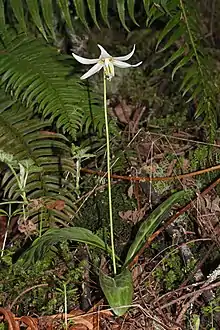| Erythronium oregonum | |
|---|---|
 | |
| Scientific classification | |
| Kingdom: | Plantae |
| Clade: | Tracheophytes |
| Clade: | Angiosperms |
| Clade: | Monocots |
| Order: | Liliales |
| Family: | Liliaceae |
| Subfamily: | Lilioideae |
| Tribe: | Lilieae |
| Genus: | Erythronium |
| Species: | E. oregonum |
| Binomial name | |
| Erythronium oregonum | |
| Synonyms[2] | |
|
Synonymy
| |
Erythronium oregonum is a North American species of flowering plant in the lily family which is known by the common name giant white fawnlily or Oregon fawn-lily.[3][4]

It is native to western North America, where it grows in the Pacific Coast Ranges from southwestern British Columbia to northern California.[2][5][4]
Distribution and habitat
In North America from southern British Columbia south to northern California, west of the Cascade Range to the Coast Range and Siskiyous.[6] It grows in meadows, rocky outcrops, and coniferous forests.[3]
Description
Erythronium oregonum is wildflower growing from a bulb 3 to 5 centimeters wide and produces basal, lance-shaped green leaves up to 22 centimeters long and often mottled with brown and white. Thin naked stalks reach up to about 40 centimeters in height, each bearing one flower or sometimes more.[7]
Each flower has white tepals with yellow bases, sometimes streaked with dull red. The flower is often nodding, facing the ground. Its tepals are recurved so their points face upward. The stamens and stigma are white and the anthers may be white to yellow. They are pollinated by beetles and flies.[7]
Uses
Bears have been known to eat the entire plant.[7]
Native Americans ate the roots raw or cooked.[7]
History
"John Burroughs is said to have named this species 'fawn lily' because he thought the two leaves looked like the pricked ears of a fawn. more likely, 'fawn' alludes to the mottled leaf coloring."[8]
References
- ↑ "Erythronium Oregonum". NatureServe Explorer. NatureServe. Retrieved 2018-04-01.
- 1 2 Kew World Checklist of Selected Plant Families
- 1 2 "Erythronium oregonum in Flora of North America @ efloras.org". www.efloras.org. Retrieved 2022-09-29.
- 1 2 "Erythronium oregonum Calflora". www.calflora.org. Retrieved 2022-09-29.
- ↑ Biota of North America Program 2014 county distribution map
- ↑ "Erythronium oregonum | Oregon fawn lily | Wildflowers of the Pacific Northwest". www.pnwflowers.com. Retrieved 2018-04-01.
- 1 2 3 4 Fagan, Damian (2019). Wildflowers of Oregon: A Field Guide to Over 400 Wildflowers, Trees, and Shrubs of the Coast, Cascades, and High Desert. Guilford, CT: FalconGuides. p. 56. ISBN 978-1-4930-3633-2. OCLC 1073035766.
- ↑ Pojar, Mackinnon, Jim, Andy (1994). Plants of the Pacific Northwest Coast. Vancouver, BC: Lone Pine Publishing. p. 104. ISBN 1-55105-040-4.
{{cite book}}: CS1 maint: multiple names: authors list (link)
External links
- Jepson Manual Treatment - Erythronium oregonum'
- United States Department of Agriculture Plants Profile: Erythronium oregonum'
- Erythronium oregonum' - Calphotos Photo gallery
